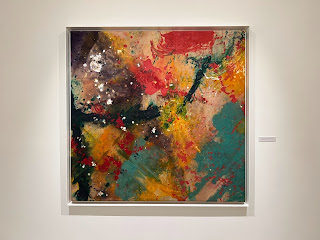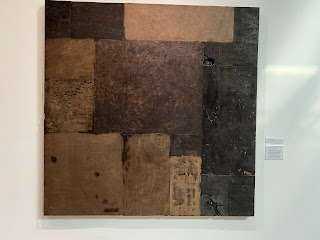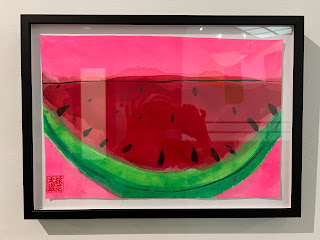In the main room, there are two wonderful examples, one I photographed and one I did not: here, the most magnificent Paul Jenkins I have ever laid eyes on. (PJ 1923 - 2012) Phenomena Palace Change, 1975-6 - and it's huge, but I don't know the dims - I'd guess 12, 14 feet long.
Another view of the Jenkins. Frances Trombly had a beautiful vertical hanging in pink and cream tones with long tassels, but I couldn't get to it.
A series of works on paper by Polly Apfelbaum kicking off a segment on "Chromatic Structures," or how color blocking reveals the power of color vs. rational geometry.
A stellar Bernard Frieze nearby, the surface impeccably primed, almost like a latex.
Many Stellas in Florida, of prize Protractor vintage. This by far and away the best, also reminding me of what I saw as a child at the then-Pasadena Museum of Modern Art. Stella's Hagmatana I, 1967, simply the best I've ever seen. (At Basel, Yares (NYC) featured Stella's first-ever painting at Princeton, a brushy black painting--make that second-best for Stella).
Spectacular weaving of printed bags by an artist in CdMX.
Display of lights in its own darkened room.
Candida Alvarez. The painting comes into focus in the camera lens--the lighting is spectacular, as is the color and surface of the painting.
A small and early Al Held, wonderful to see, almost a Renaissance composition.
A rather larger Summer Wheat, in which the paint is funneled through a screen.
Sam Gilliam, early vintage. Again, his breakthrough made more important by seeing these early compositions.
Etel Adnan weaving. Definitely my favorite work by her for moving beyond the comfort of scale and translating another medium.
Colombian-born Fanny Sanin (b. 1938) and her magnificent Acrylic No. 2, 1990. What a gift to learn about this painter, based in New York! According to her web site, "Sanín was born in Bogotá, Colombia and earned a degree in Fine Arts at the University of the Andes. She continued her education with graduate studies at the University of Illinois and the Chelsea School of Art in London. During her early career she resided in Monterrey, Mexico and since 1971 she has lived and worked in New York, NY."
Gene Davis - and here I thought working on unprimed canvas was revolutionary! He was doing it when I was 20!
Landscape Gestures section, which links color to organic earth material, and weaving to arial views of the landscape. Here, the glorious Joan Mitchell I photographed at PAMM in 2018.
Kenneth Noland--took me by surprise. Now can't remember if early but would certainly think so.
Alice Wagner, b. 1974.
Random Intersections #10 by Leonor Antunes, Portugese, b. 1972, shows with Marion Goodman. Leather and brass hardware.
Helen Frankenthaler. Vanilla, 1978. I love finding these examples of work that don't see the light of day usually.
Kapwani Kiwanga's sisal fiber and painted steel Sisal 1, 2021. In 1891 German colonizers introduced sisal in Tanzania, and built a market for it until its independence in 1960, when it collapsed. Guggenheim recipient Kiwanga lives and works in Paris.
French-Algerian artist Kader Attia, 1970, France. Untitled (burnt wood) picture, 2007.
LA-based interdisciplinary artist Gala Porras-Kim, b. 1984, Colombia. 78 West Mexico Ceramics in LACMA Collection, Nayarit Index, 2017. Whole view.
Gala Porras-Kim. Detail.
Abel Rodriguez and Aycoobo Wilson Rodriguez, b. 1941 and 1967, both Colombian;
Arbol de Ceiba, 2018, acrylic on paper, and Terraza baja, 2018, acrylic on canvas
Sheila Hicks
A spectacular early Yinka Shonibare CBE, Girl/Boy, 1998
Sonia Gomes, b. 1948, Brazil. She lives in Brazil and is represented by Pace. She works with fabrics gifted to her and works spontaneously within community.
Spaniard Nacho Martin Silva's En lo Oculto, 2018, oil on linen.
el Origin del Circulo II, 2014, by Oscar Abraham Pabon.
Tania Candiani, Lipo Front and Back, 2002-5, searing portrtayal of pre-surgical analysis of women who don't suit prevailing social ideals, whether by weight or by age
Yanira Collado's large scale fabric montage ruminating on her historical past
Brazilian Laura Lima's Leviata, 2019, dyed cotton yarn
Conrad Marca-Relli, 1913-2000, L-4-72, 1972, Oil and canvas collage on canvas
Ernest Neto! I would not have guessed. Cotton voil crochet and wooden knobs, referencing myths related to the Huni Kuin people of the Amazon region with whom Neto has been living and working. Snakeskin pattern enters into this "body". (We are in the body section, but I did not record it).
Closing with a Kenneth Noland rug.
Hands down this show was the most miraculous exhibition I saw in Miami. This is how a collector collects. It is spectacular.














































































